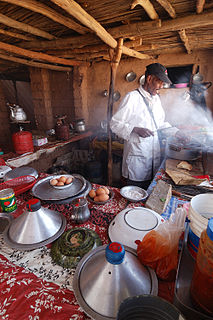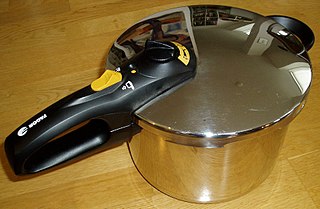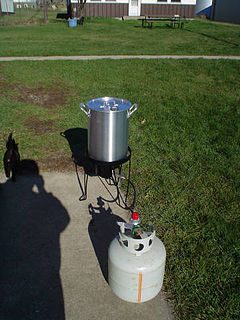
Cooking,cookery, or culinary arts is the art, science, and craft of using heat to prepare food for consumption. Cooking techniques and ingredients vary widely, from grilling food over an open fire to using electric stoves, to baking in various types of ovens, reflecting local conditions.

French fries, chips, finger chips, French-fried potatoes, or simply fries, are batonnet or allumette-cut deep-fried potatoes, originating from either Belgium or France. They are prepared by cutting the potato into even strips, then drying and frying it, usually in a deep fryer. Most french fries are produced from frozen Russet potatoes.

Deep frying is a cooking method in which food is submerged in hot fat, traditionally lard but today most commonly oil, as opposed to the shallow oil used in conventional frying done in a frying pan. Normally, a deep fryer or chip pan is used for this; industrially, a pressure fryer or vacuum fryer may be used. Deep frying may also be performed using oil that is heated in a pot. Deep frying is classified as a hot-fat cooking method. Typically, deep frying foods cook quickly: all sides of the food are cooked simultaneously as oil has a high rate of heat conduction.

Pan frying or pan-frying is a form of frying food characterized by the use of minimal cooking oil or fat, typically using just enough to lubricate the pan. In the case of a greasy food such as bacon, no oil or fats may need to be added. As a form of frying, the technique relies on oil or fat as the heat transfer medium, and on correct temperature and time to not overcook or burn the food. Pan frying can serve to retain the moisture in foods such as meat and seafood. The food is typically flipped at least once to ensure that both sides are cooked properly.

Grilling is a form of cooking that involves dry heat applied to the surface of food, commonly from above, below or from the side. Grilling usually involves a significant amount of direct, radiant heat, and tends to be used for cooking meat and vegetables quickly. Food to be grilled is cooked on a grill, using a cast iron/frying pan, or a grill pan.

Pressure cooking is the process of cooking food under high pressure steam, employing water or a water-based cooking liquid, in a sealed vessel known as a pressure cooker. High pressure limits boiling, and permits cooking temperatures well above 100 °C (212 °F) to be reached. Pressures up to one atmosphere above STP are generally employed.

Stir frying is a Chinese cooking technique in which ingredients are fried in a small amount of very hot oil while being stirred or tossed in a wok. The technique originated in China and in recent centuries has spread into other parts of Asia and the West. It is similar to sautéing in Western cooking technique.

A microwave oven is an electric oven that heats and cooks food by exposing it to electromagnetic radiation in the microwave frequency range. This induces polar molecules in the food to rotate and produce thermal energy in a process known as dielectric heating. Microwave ovens heat foods quickly and efficiently because excitation is fairly uniform in the outer 25–38 mm(1–1.5 inches) of a homogeneous, high water content food item.

Blanching is a cooking process in which a food, usually a vegetable or fruit, is scalded in boiling water, removed after a brief, timed interval, and finally plunged into iced water or placed under cold running water to halt the cooking process. Blanching foods helps reduce quality loss over time. People often use blanching as a treatment prior to freezing, drying, or canning—heating vegetables or fruits to inactivate enzymes, modify texture, remove the peel, and wilt tissue. The inactivation of enzymes preserve color, flavor, and nutritional value. The process has three stages: preheating, blanching, and cooling. The most common blanching methods for vegetables/fruits are hot water and steam, while cooling is either done using cold water or cool air. Other benefits of blanching include removing pesticide residues and decreasing microbial load. Drawbacks to the blanching process can include leaching of water-soluble and heat sensitive nutrients and the production of effluent.

A convection oven is an oven that has fans to circulate air around food which gives a very even heat. The increased air circulation causes a fan-assisted oven to cook food faster than a conventional non-fan oven, which relies only on natural convection to circulate the hot air. Fan-assisted convection ovens are commonly used for baking as well as non-food, industrial applications.

A deep fryer, is a kitchen appliance used for deep frying. Deep frying is a method of cooking by submerging food into oil at high heat, typically between temperatures of 350 °F and 375 °F.

A turkey fryer is an apparatus for deep-frying a turkey. Fried turkey has been a popular item in the Southern United States, and has recently become popular in other parts of the country because of the reduced time needed to cook a turkey in a deep fryer, versus other conventional methods such as an oven or a rotisserie grill.

The following outline is provided as an overview of and topical guide to food preparation:

Heavy-duty cookware made of cast iron is valued for its heat retention, durability, ability to be used at very high temperatures, and non-stick cooking when properly seasoned. Seasoning is also used to protect bare cast iron from rust. Types of cast iron cookware include frying pans, dutch ovens, griddles, waffle irons, flattop grills, panini presses, crepe makers, deep fryers, tetsubin, woks, potjies, and karahi.
A vacuum fryer is a deep-frying device housed inside a vacuum chamber.

Fried chicken, also known as Southern fried chicken is a dish consisting of chicken pieces that have been coated with seasoned flour or batter and pan-fried, deep fried, pressure fried, or air fried. The breading adds a crisp coating or crust to the exterior of the chicken while retaining juices in the meat. Broiler chickens are most commonly used.

Shallow frying is a hot oil-based cooking technique. It is typically used to prepare portion-sized cuts of meat, fish, potatoes and patties such as fritters. Shallow frying can also be used to cook vegetables.

Frying is the cooking of food in oil or another fat. Similar to sautéing, pan-fried foods are generally turned over once or twice during cooking, using tongs or a spatula, while sautéed foods are cooked by "tossing in the pan". A large variety of foods may be fried.

An air fryer is a small countertop convection oven designed to simulate deep frying without submerging the food in oil. A fan circulates hot air at high speed, producing a crisp layer via browning reactions such as the Maillard reaction. Some product reviewers claim that regular convection ovens or convection toaster ovens produce better results or that air frying is essentially convection baking under a trendy new name.



















